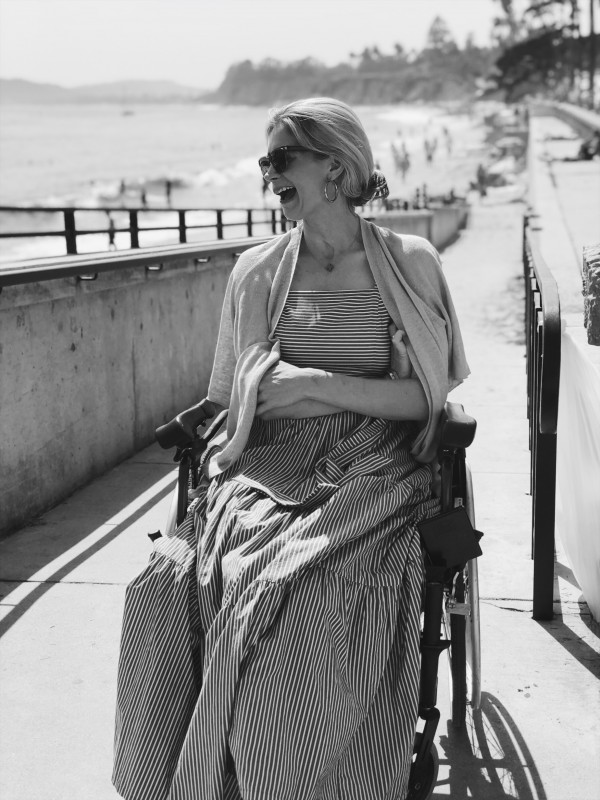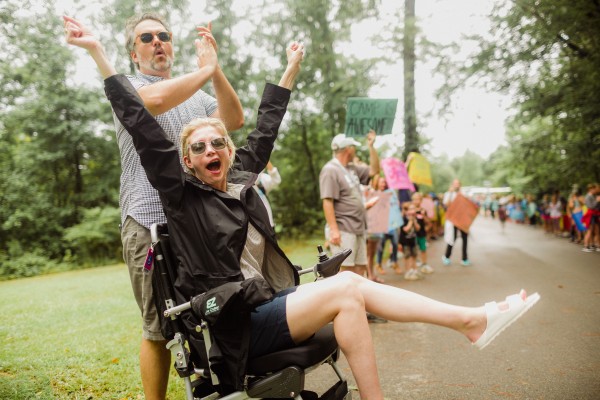My relationship to beauty and satisfaction with my body has always been complicated at best. I was raised in the Deep South by women who dared not leave the house without “putting on their face” first. Then, I worked as a model and actress in LA…which will obviously mess anyone up! It seemed all that would end when I had a baby at age 25. But it would ALL literally nearly end when I suffered a catastrophic brainstem stroke out of the blue six months later.

In the blink of an eye, I could no longer walk, talk, eat, drive, or care for my son. The post-partum pooch and bags under my sleep-deprived eyes suddenly paled in comparison to the reality that my body and brain no longer worked like they used to. Pregnancy and new motherhood had changed my body distinctly. Now, after the near-fatal stroke, the body in which I lived was not only different but altogether unknown and unsafe. Where do you run when your own body turns on you?

Over years spent in rehab, I learned new ways of navigating the world in my modified state. But, even in the healing and adapting, so many disabilities remained. My face is paralyzed on the right side. I can’t walk well and mostly require a wheelchair to get around. I can’t drive. I have severe double-vision and lack fine motor control is my right hand. I struggled to love my body when it was “normal”. How was I expected to love it now?
So many of us have internalized messages that we must meet certain metrics to gain acceptance. You’ve gotta look good while you do good. You’ve gotta pull it all together and not let anything unappealing hang out. You’ve gotta be enough but also not too much. In other words, to be loved by others requires that we put in a lot of effort and put on a lot of makeup.
Beneath our pursuit of external beauty and eternal youth is both a deep fear—to escape death—and a deep longing—to be loved without having to earn it. Our pain and death avoiding culture tries to calm our fears of aging with every manner of pulling and prodding, slicing and shaming. Buy this. Eat that. Be young and beautiful forever. But the question becomes, who is telling us the story of our beauty?
While my stroke stole much of my independence and some of my “traditional beauty”, it also freed me from the lie that death can be outrun. I met death when I was 26. The magnitude of that experience means I no longer feel the need to cover up my flaws or conceal my brokenness—both physical and emotional— because I now know that life is simply too precious and short to carry the burden of shame.

Being satisfied in our skin isn’t so much about looking the right way. It’s about surrendering the expectations and wounds surrounding all the things we think we lack. When our eyes move past our own navels and onto the panoramic view of the goodness of our existence and the world around us, shame no longer has a place in our story.
We can be grateful for each facet of our inner and outer selves because the beautiful stuff and the broken stuff work together to create the lives, families, passions and purposes we have today. We can train ourselves to celebrate the cellulite because it’s sprinkled on the body that allows us to engage existence. I’m even training myself to celebrate my broken brain because it didn’t ruin my perfect life. Rather, it gave me the gift of a good/hard life.
Just before my stroke, my body birthed a baby boy, James. Then, my post-stroke body—the one that didn’t seem to do anything it was meant to do—grew another life, our second son and miracle baby John. This time, my bulging belly and creeping stretch marks became sacred rather than scary. My busted-up body made a baby—my own living reminder that beauty can come from brokenness and new life can come from near death.
 .
. 
My losses may have redefined me, but I have redefined my losses and made them reminders that my worth was never tied to my facial symmetry or my physical functioning. I am freed from the crippling burden of chasing youth or the perfect figure because my gaze is transfixed on the miracle of existing rather than my imperfections. And it doesn’t take a brainstem stroke to start intentionally walking away from shame toward a beauty that never fades.

When I look at my paralyzed face, I see a woman in the process of transformation. When I see stretch marks from pregnancy, I see my beautiful children who came from my body. When I see stretch marks that aren’t from pregnancy, I see bountiful feasts I’ve enjoyed. When I see bags under my tired eyes, I see a hard-won second chance at life. When my standard of beauty is redemption, not weight; when it’s sacrifice, not self-absorption; when it’s new life, not chasing youth gone by, I can see how my body embodies the grace gift of a second chance at simply existing. And what could be more beautiful?
To learn more about Katherine Wolf and her story, check out her forthcoming book, Suffer Strong: How to Survive Anything by Redefining Everything (February 11, 2020) and follow along via Hope Heals.
This post comes from the TODAY Parenting Team community, where all members are welcome to post and discuss parenting solutions. Learn more and join us! Because we're all in this together.
